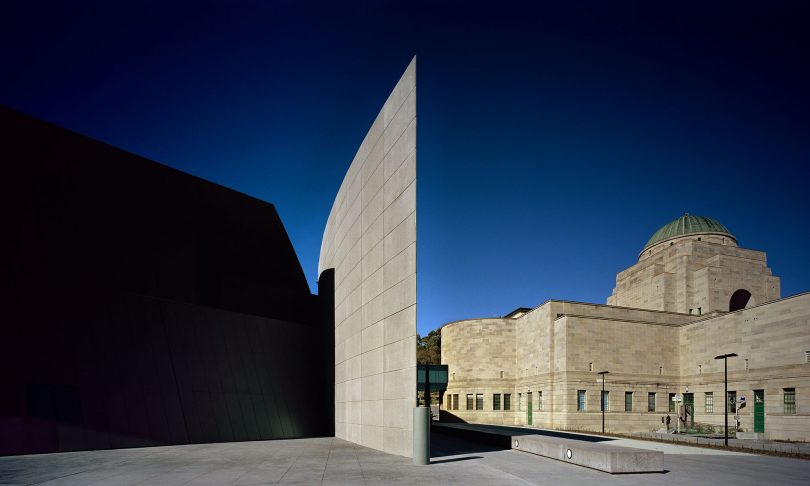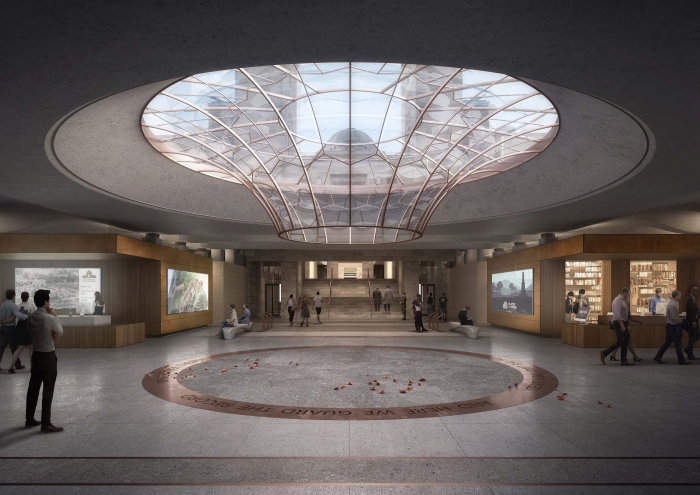
The award-winning Anzac Hall will be demolished. Photo: Australian Institute of Architects.
The Australian Institute of Architects has urged members of Parliament to reject the $500 million redevelopment of the Australian War Memorial in a bid to save the award-winning Anzac Hall from demolition.
The controversial expansion plans for the Memorial have been attacked by a range of interest groups and prominent individuals on heritage, philosophical and cost grounds. But in an open letter to all members of the House of Representatives, the Institute’s 2018-19 national president Clare Cousins has homed in on the threat to Anzac Hall, calling its destruction wasteful and unnecessary.
Ms Cousins also criticises what the Institute sees as a lack of due process in the way the demolition of Anzac Hall was included in the redevelopment proposal, how it is being assessed and limited public consultation, and is now calling for a public inquiry.
She says the Institute appreciates there may be a need to increase the Memorial’s capacity, but not in a way that is wasteful, destructive and damaging to the heritage value and integrity of the site, warning that over-development will lead to significant adverse loss of the qualities that make the AWM nationally significant.
”We oppose the planned unnecessary destruction of Anzac Hall, a building that was painstakingly designed and crafted to honour this service to our nation,” Ms Cousins says.
”Anzac Hall is a building that forms an integral part of the War Memorial site itself, whose sacred and special significance is the sum of all its parts.”
The AWM is included on the Australian Institute of Architects’ register of Nationally Significant 20th-Century Architecture, and in 2005, architects Denton Corker Marshall (DCM) won the Institute’s prestigious national Sir Zelman Cowen Award for Public Architecture.
Ms Cousins believes the 19-year-old building would in time achieve heritage listing in its own right and that demolition of such a young and significant building should never have been considered appropriate.
She says there is absolutely no reason why Anzac Hall cannot be retained, and the aims of the Development Project still be delivered.
Its demolition would also set a dangerous precedent for other prominent sites.
Ms Cousins notes that Anzac Hall contributed to the Memorial’s Commonwealth Heritage Listing and its loss would contravene management policy in both the (current) 2011 and (pending) 2019 Heritage Management Plans.
”Allowing legislated heritage protections to be so blatantly disregarded in this instance, and for such a prominent public institution, would set a dangerous precedent for other iconic sites.”

A concept illustration of the Oculus at the southern entrance. Image: AWM.
Ms Cousins identifies that the Memorial has committed itself to a proposal that included the demolition of Anzac Hall before any approvals have been given for demolition or new development.
She adds that the demolition of Anzac Hall was a mandatory requirement in the reference design and expression of interest process to expand the Memorial facilities despite three other preliminary designs meeting the same floor space requirements but retaining Anzac Hall.
”The EOI process should have been an opportunity for architects to explore unrestricted outcomes that met brief requirements, and indeed we are aware of at least one response that retained Anzac Hall while successfully meeting the remaining conditions and criteria of the brief.”
Other concerns include approvals being granted for related works such as car parks before the full approvals process has been worked through and the Parliamentary Public Works Committee inquiring into the project at the same time as the referral under the Environment Protection and Biodiversity Conservation Act (EPBC) without having an updated and approved Heritage Management Plan in place.
Assessment of the project by the Department of Agriculture, Water and the Environment also initially excluded key aspects of the development including the research centre addition to the CEW Bean Building and a significantly enlarged parade ground.
Ms Cousins says the amount of new documentation related to a major variation to the scope of the proposal has compromised the public consultation component of the EPBC process.
”Given the scale of the new documentation and the potential cumulative heritage impacts of the planned development at the AWM, it is the view of the Institute that the Department of Agriculture, Water and the Environment should immediately halt the referral, review the processes undertaken to date and consider if it is now more appropriate for the referral to be undertaken via public inquiry,” Ms Cousins writes.
She says the Public Works Committee should not make any finding without examining the results of the EPBC referral.
Original Article published by Ian Bushnell on The RiotACT.








